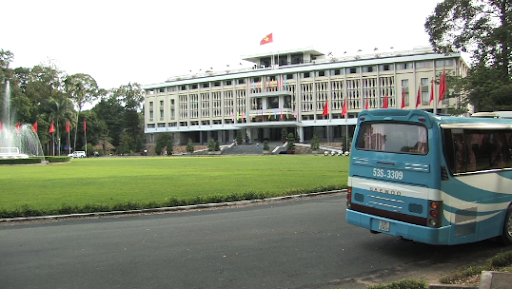You don't have to travel very far from its airport to reach the thick of Ho Chi Minh City. The city announces itself with irritating hums and honks from swaths of mopeds clogging its arteries. Somehow traffic flows, but I saw at least three collisions between bikers during my 20 minute drive from the terminal to my hotel. One was at slower speed, and it was humorous watching the two men stand up, brush themselves off, nod in mutual apology and drive off as if it were part of some expected ritual.
Formerly known as Saigon before the North Vietnamese defeated their capitalist brothers to the south, HCMC is still the hub for innovation in the country, and it - not Hanoi - is the steward of the recent free-market resurgence in the country. Make no mistake, it is still a socialist republic with a single, heavy handed ruling party. But unlike its much bigger communist neighbor, China, only 2.3% of Vietnamese citizens are actually card-carrying members of their nation's communist party.
Nevertheless, communism and its history in and influence on the country is difficult to miss - most notably at the War Remnants Museum. Situated smack dab in the middle of the city, this quirky homage to the Vietnam war displays abandon tanks and other contra either left by the U.S. and French or brought into the city by the Viet Cong when it took the city in 1975. The placards under the specimens cater shamelessly to the party's take on the times: "This M24 tank was commandeered by the liberating forces...," a subtle snub at the museum's 95% U.S. patronage. The museum houses other, darker exhibits as well.

At the Reunification Palace, two Russian-built tanks - of the same model that broke down the building's gates to secure the Norh's victory - stand proudly in the courtyard with a fresh coat of army green. The palace was built in 1966 for South Vietnam's president. It has been left as it was taken in 1975 and opened up as a museum. Historical significance is the only thing making this structure worth visiting, and perhaps the shell of an F4 Phantom in the back lawn.

An odd thing about HCMC is that everyone wants to take you for a ride - literally. Walking for several hours through the city, I was courted continually by moped drivers offering to show me around the entire city for 30,000 dong. I had to laugh at the image of myself, 6' 4" clinging to a 5' 2" Vietnamese man on the back of a rickety Vespe. I politely declined each offer.
Really, the best way to get around HCMC is by foot. You would miss too much with motorized transportation. And the thrill of crossing a HCMC street, dodging cars, busses, and bikes alike, doubles as an extreme sport (Maintaining eye contact with the person's bike you are going to step in front of is key).
The only issue with walking is dealing with the street hawkers. For example, a young girl approached me as I was sitting at a corner, getting off my feet and admiring the Notre Dame cathedral. She was hellbent on selling me flowers, employing the rule of the five whys to counter my refusal. "You want to buy a flower," she said in perfect English. "No thank you," I said. "Why?" she replied. "Because I don't have any money," I lied. "Why?" "Because I don't have a job." Why? "Because I'm not so bright," "Why?" I gave in: "How much?" I paid 5000 dong for a wilted carnation (which she probably picked from a nearby park). I realized my mistake when several more children emerged from their hiding places to sell me postcards, kleenexes, coconuts, Vietnamese flags, and other trinkets and mementos. The savvy flower salesgirl strode away grinning.

